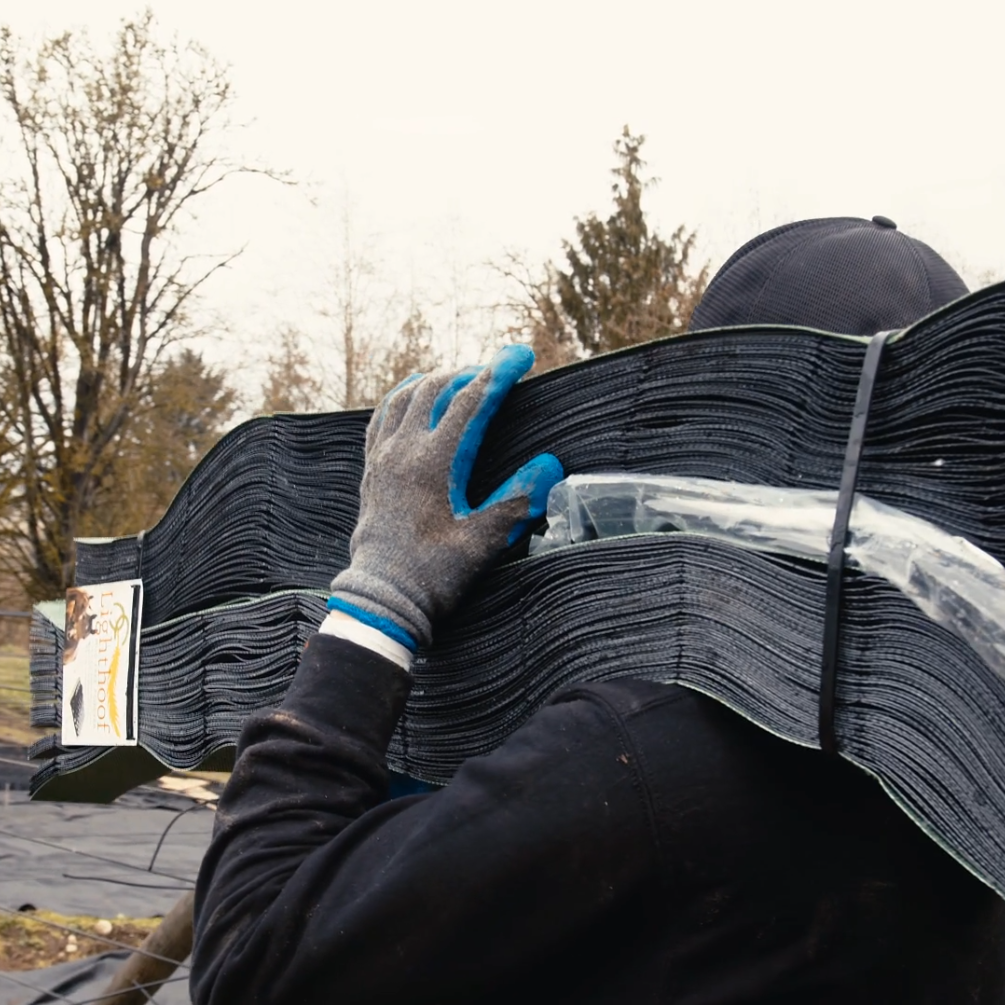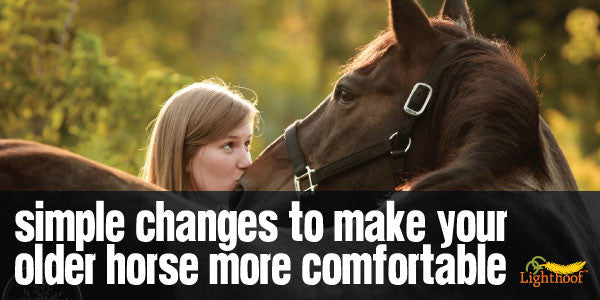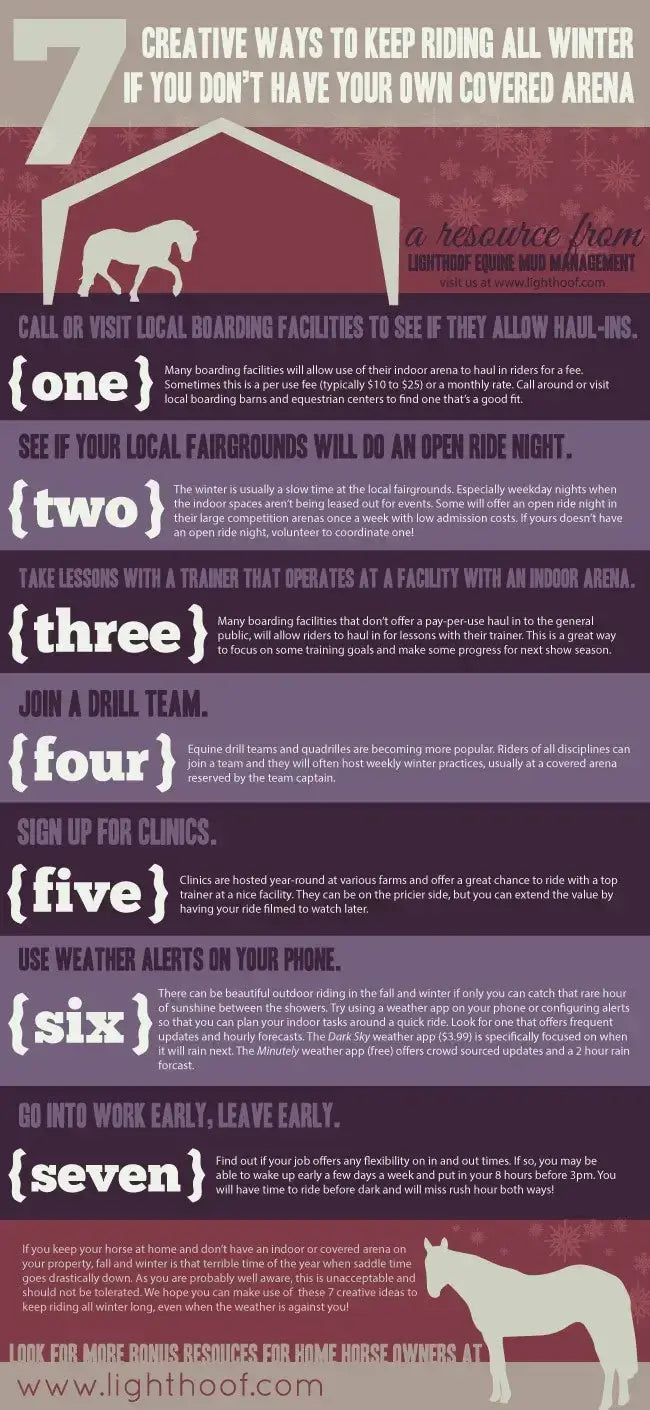Horses, like people, start developing more aches and pains as they age. The major difference is that horses are usually much less vocal about these new aches and pains as they arise. Extra considerate horse owners try to predict what new challenges their senior horses might be facing and do their best to mitigate any potential discomforts. If your horse is 18 or beyond and starting to, or continuing to, show some signs of arthritis, here are a few simple changes to her routine that could help her enjoy her golden years even more.
Farrier Visits
For the senior horse, farrier visits can be very uncomfortable or even painful to endure. Long periods standing still on hard ground, bending up a stiff limb or even the impact of the hammer when nailing on shoes can be troublesome for some seniors. Here are some ways to improve the experience for your horse if you notice that she seems uncomfortable during farrier visits.

Consider administering an NSAID (Bute or Banamine) before trimming or shoeing.
Talk to your vet and explain the situation being sure to take all health issues into account. NSAIDs can work wonders to reduce your senior horse's pain and stiffness when administered prior to shoeing but should be used with caution. Here is a great article on TheHorse.com about how NSAIDs work, their uses, and potential issues.
Break up your senior horse's shoeing with frequent rest periods.
If your farrier has other horses to do at the barn, give her a break between the fronts and backs or even every 5-10 minutes. Letting her walk it off in a small paddock while another horse is getting his trim, or even just return to her stall for a few bites of hay after each hoof is done can make the world of difference.
Use props well.
Make good use of the hoof stand or other safe tools to save your farrier’s back and give her something to rest on. A good adjustable hoof stand is invaluable in shoeing or trimming an older horse. Allowing the horse to relax onto a prop set to the right height at the right angle will make everyone more comfortable.

Let your farrier know so that he can adjust his technique.
If you give your farrier a heads up that your senior horse gets uncomfortable during shoeings, he might adjust his work style to make things easier on her. For example, our fabulous farrier is very mindful of how high my senior horse has to lift each hoof, what angle her leg should be to her body for maximum comfort, and how long he can hold up a hoof before she needs a break.
Trailering
We don't realize it with our comfy seats and complex suspension systems, but hauling can be as strenuous as riding for horses. Bracing against the forward to back and side to side movement requires constant flexing of muscles and joints and standing in once place can make arthritic horses very stiff.
Break up long trips with a chance to get out and walk around.
If you are traveling for more than an couple hours with your senior horse, it's best to plan some horse-safe rest stops along the way. When you stop, unload your horse and hand graze or walk around for 10 minutes or so. Offer her some water, make sure she's not too cold or too warm, and check her over for signs of stress. There should be some poop in the trailer or she should have a healthy looking BM while she's out of the trailer.

Make sure your rest stops are in a safe place to load and unload, not right next to a busy road. Look for horse parks, fairgrounds, or horse hotels along your route. A quick google ahead of time will leave you with some options to pick from once you are on the road.
Stop every 20-30 minutes and let her shift her stance and take a short rest.
Many vets advise pulling off the main road and letting your senior horse rest in a stationary trailer every 20-30 minutes. Simply pull a safe distance off the road, into a gas station or lunch spot perhaps, and turn the truck off for a minimum 5 minute break without unloading. Don't leave your horses alone in the trailer and go into a restaurant or something where you can not see them. Make sure someone is in sight or hearing distance of the trailer in case there is trouble.
Stalls vs. Paddocks
Maybe you've heard the phrase,“People don't stop moving when they get old. People get old when they stop moving.” Well, it's not far from the truth for a number of reasons, one being stiffness in the joints. A senior horse that's stalled for long periods of time can have more pain and stiffness than one who's able to keep moving more. If your horse lives in a traditional barn and is stalled at night, consider finding a situation with an in-and-out run off her stall or some kind of living situation that allows more freedom of movement on a 24/7 basis.

Some options include shed row style living in a paddock with a 3-sided shelter, provided measures have been taken to make the paddock mud-free in the wet season, pasture board on acreage, or a "paddock paradise" type living arrangement with lots of room to explore. The other benefit to an outdoor boarding situation is that it's typically less expensive than a stall boarding situation. If you are lucky enough to retire your senior at home, then you have the freedom and flexibility to create a living situation that caters to her need for gentle movement and is convenient for you to take care of and visit with her.
Weather Changes
Be considerate that colder weather increases joint pain and stiffness. A drop in temperature is noticed right away by the senior horse and a long, cold winter will be a time when you have to be more sensitive to her needs. Some things to think about:
- Give your senior horse longer warm-ups and cool-downs when riding.
- Provide access to dry indoor or mud-free outdoor living areas. (See Lighthoof for more info on creating a mud-free paddock)
- Add a digestive support supplement such as pre/probiotics in times of cold-weather stress.
- Consider an herbal, natural, or pharmaceutical anti-inflammatory in the colder months.
- Make sure she is drinking enough water. See our 6 Tips to Keep Your Horse Hydrated in Winter
- Help her thermoregulate by removing and replacing blankets as needed.
Senior Horse Supplements & Medications
Not every horse needs supplements, however the arthritic senior horse will benefit tremendously from some additional nutritional support. There are many blends of joint supplements designed specifically for senior horses at different levels of joint discomfort and activity. A major supplement retailer like SmartPak will have good resources for comparing your options. Here's what you need to consider:
- Nutritionally support her body’s joint lubrication. Glucosamine Sulfate is the major contributor to this.
- Nutritionally support her inflammation response. Many herbs and supplements can provide this benefit.
- Talk to your vet about any supplements you provide and if anti-inflammatory or pain management medications are required.
Being able to care for a senior horse and make her golden years wonderful is one of life's greatest pleasures. Our horses give us so much, it's a joy to be able to give back to them by being sensitive to their changing needs as they age. We hope you enjoy every day with your older equine companions! Please feel free to share your stories and questions in the comments below.




Leave a comment
This site is protected by hCaptcha and the hCaptcha Privacy Policy and Terms of Service apply.